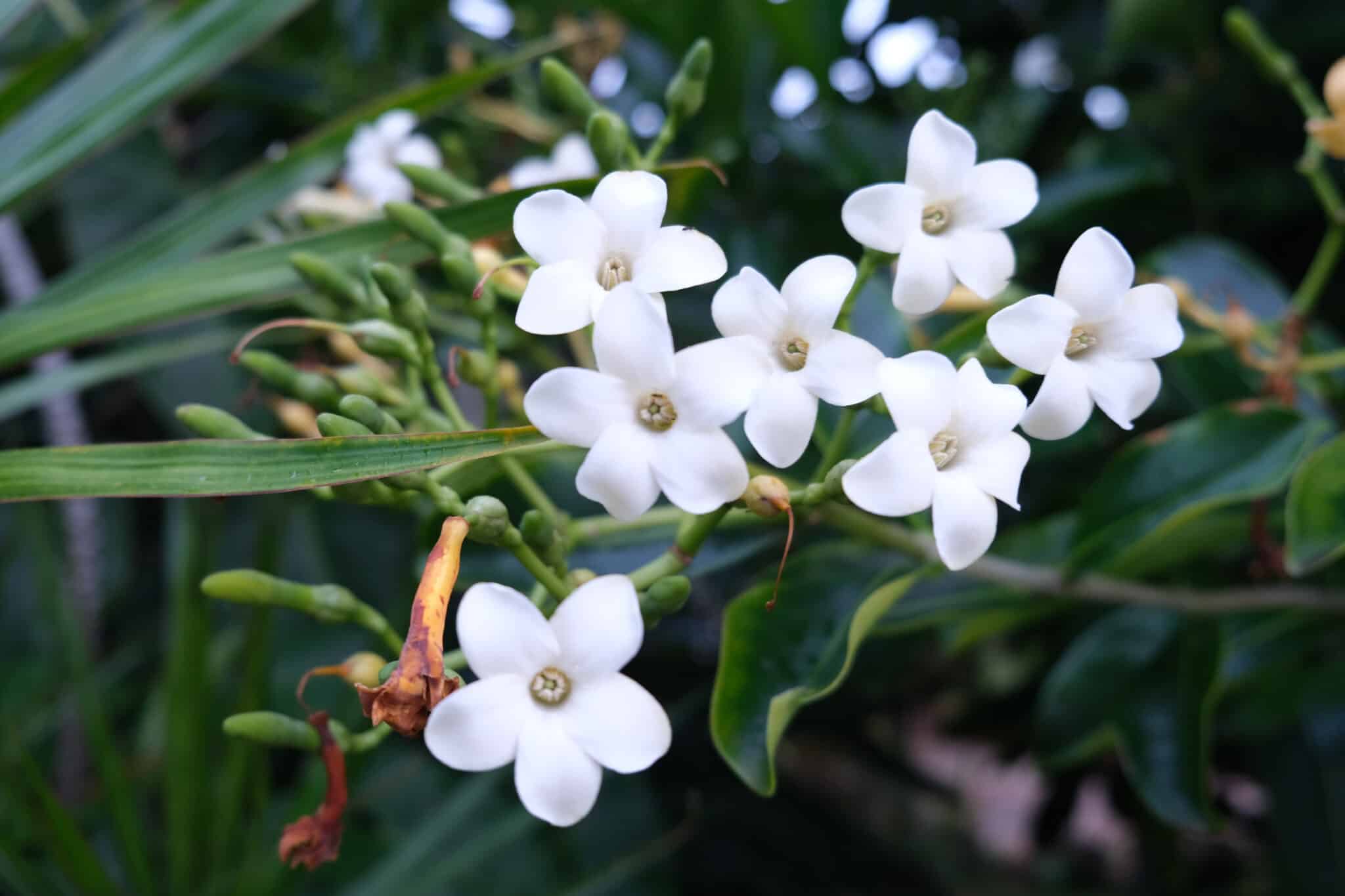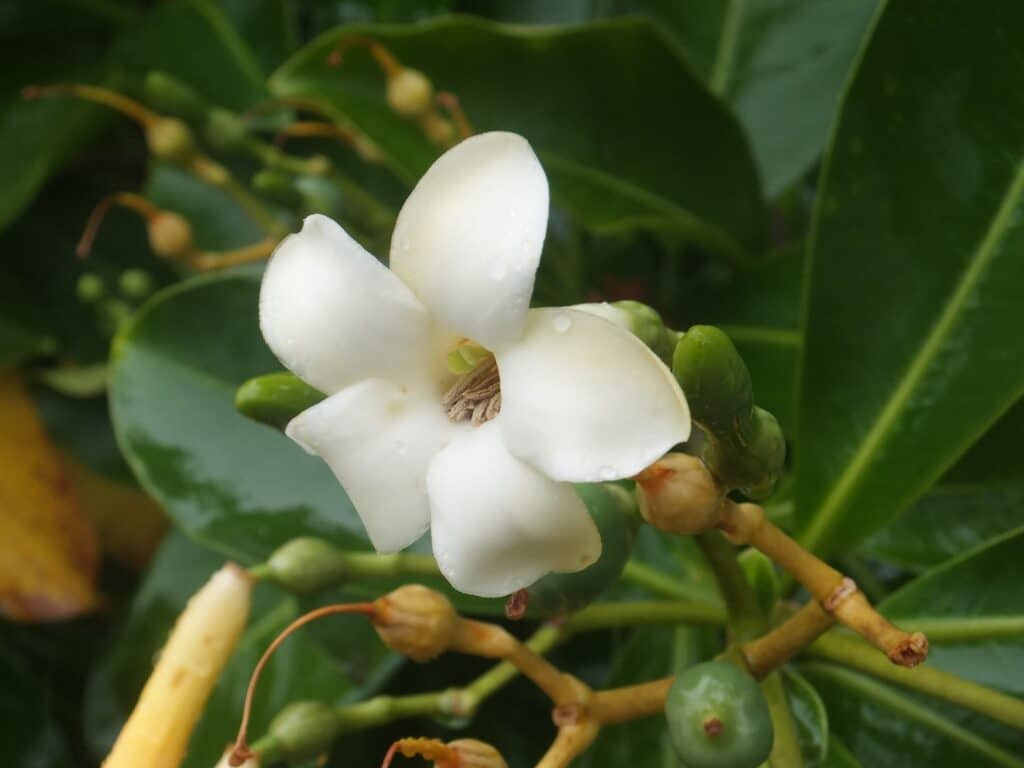Puakenikeni, also known as Fagraea berteroana, is beloved for its intoxicating fragrance and elegant blossoms. Native to tropical regions, Puakenikeni holds a cherished place in Hawaiian gardens, especially in areas like Mililani and Lanikai. Its name means “ten cent flower,” referencing its popularity and value in lei making. Gardeners and landscape enthusiasts adore Puakenikeni for both its beauty and symbolic importance.
This tree blooms profusely, offering creamy white flowers that mature into deep orange hues. Its aromatic flowers are not only decorative but deeply embedded in Hawaiian culture and ceremonies. Throughout the year, especially in warm months, it becomes a centerpiece in many island yards. Homeowners appreciate how easily it integrates into various garden styles.
Understanding the nuances of Puakenikeni cultivation helps gardeners make informed decisions. Whether you are seeking the best time to plant or tips for ongoing maintenance, comprehensive knowledge ensures thriving growth. With the right conditions, this tropical treasure thrives for years. It rewards care with abundant blooms and captivating scents.

Puakenikeni – Fagraea berteroana Details
Puakenikeni, or Fagraea berteroana, is a tropical flowering tree native to the Pacific Islands. It belongs to the Gentianaceae family and is well known for its fragrant, tubular flowers. These blossoms start creamy white, aging to deep yellow and eventually rich orange. Their captivating scent makes them a popular choice for leis and tropical arrangements.
In Hawaii, Puakenikeni grows well in warm, humid environments like those found in Mililani and Lanikai. The tree can reach heights of up to 30 feet, with a rounded canopy and dense foliage. Its leathery green leaves offer year-round greenery, even when not in bloom. The flowers bloom frequently, especially with proper sunlight and watering.
Puakenikeni has significant cultural value in Hawaiian traditions, symbolizing love, respect, and celebration. The name means “ten cent flower,” a nod to its traditional price per blossom in lei markets. Gardeners appreciate both its beauty and cultural roots, which add depth to any landscape. It is a living connection to island heritage.
This plant thrives with minimal effort in the right conditions, making it a favorite among home gardeners. With basic care, Puakenikeni remains a long-lasting addition to your garden. Understanding its botanical background helps ensure its proper placement and care. Puakenikeni is more than a flower, it is a piece of Hawaiian identity.
Varieties and Cultivars
Puakenikeni comes in a few distinct varieties, each with subtle differences in growth habits and flower characteristics. Gardeners in Mililani and Lanikai often favor compact forms for residential spaces. Larger cultivars are excellent for creating shade and adding structure to tropical landscapes. Regardless of size, all cultivars share the same captivating fragrance and vivid blossoms.
The most common variety grows into a medium-sized tree with lush green leaves and cream-to-orange flowers. Some hybrids offer improved disease resistance and faster blooming cycles, making them popular with hobbyists. Dwarf cultivars, which rarely exceed ten feet, are perfect for container gardens or small yards. These versions still produce the iconic Puakenikeni flowers in abundance.
Choosing the right cultivar depends on your garden’s purpose and available space. For lei making, traditional cultivars with large, fragrant blooms are best. If space is limited, opt for dwarf varieties that require less pruning. Each option ensures a beautiful and aromatic addition to your landscape.
Whichever cultivar you choose, growing Puakenikeni offers a rewarding experience filled with sensory delight. Understanding these variations makes plant selection easier and more purposeful. In Mililani and Lanikai, these options thrive in sun-filled, well-drained environments. Puakenikeni cultivars truly enhance any tropical garden with color and fragrance.
Best Time to Plant
In Mililani and Lanikai, the best time to plant Puakenikeni is during late spring or early summer. Warmer temperatures and increased sunlight provide ideal conditions for strong root development. Planting during this season ensures rapid acclimation and robust growth throughout the year. Avoid planting during Hawaii’s wettest months to reduce transplant shock.
Puakenikeni thrives when soil temperatures remain consistently above 65°F, which is typical in these locations during May through August. This period also aligns with natural growth cycles, enhancing establishment success. Dry, sunny weather helps the plant settle without drowning delicate roots. By fall, your Puakenikeni will likely show new leaves and buds.
Spring planting allows the young tree to build strength before cooler months slow its growth. Since Puakenikeni prefers steady warmth, giving it a head start makes all the difference. Late planting may delay flower production or increase susceptibility to stress. Planning your planting window increases your chances of long-term success.
In Mililani and Lanikai, consider both rainfall and sunlight before digging in. Favor drier weeks for planting and keep new trees well-hydrated. With thoughtful timing, your Puakenikeni will bloom earlier and more frequently. Choosing the right season sets your tropical treasure on the path to lush, vibrant health.
Growing Conditions
Puakenikeni thrives in tropical climates like those in Mililani and Lanikai, where temperatures stay warm year-round. It grows best in full sun, receiving at least six hours of direct light each day. Shaded locations reduce flowering and may cause leggy growth. Always choose a sunny spot to promote healthy, vibrant blooms.
Well-draining soil is essential, as Puakenikeni dislikes sitting in waterlogged conditions. Sandy loam or light, fertile soil enriched with compost works best. If planting in containers, ensure pots have proper drainage holes to prevent root rot. Overwatering remains a common issue, so check soil moisture before adding more water.
Humidity and consistent temperatures between 70°F and 85°F keep Puakenikeni happy and flowering. Protect it from strong coastal winds, which can damage flowers and break branches. In Lanikai, consider planting near a windbreak or wall for added protection. In Mililani, natural landscaping may offer built-in shelter from breezes.
Keep in mind, Puakenikeni does not tolerate frost or extreme cold. Although rare in Hawaii, sudden temperature drops can stunt growth or cause damage. For higher elevations, monitor local weather closely before planting. With the right location and care, Puakenikeni brings fragrance and color to your garden all year long.
Planting Instructions
Planting Puakenikeni correctly ensures healthy growth and stunning blooms, especially in tropical locales like Mililani and Lanikai. Follow these detailed steps to give your tree the best start:
-
Choose the right location
Select a spot with full sun exposure and good airflow, away from strong wind currents. Avoid shaded areas that may limit flower production.
-
Prepare the planting site
Dig a hole twice as wide and slightly deeper than the Puakenikeni’s root ball. Break up compacted soil and mix in organic compost to enrich the area.
-
Position the plant correctly
Set the Puakenikeni into the hole so the top of the root ball is level with the surrounding soil. This positioning prevents water pooling at the base.
-
Backfill and settle
Gently backfill with soil, pressing down softly to eliminate air pockets. This helps stabilize the young plant and supports root contact with the soil.
-
Water thoroughly after planting
Immediately water the tree deeply to help it settle and hydrate the roots. This first watering is crucial for establishing root growth.
-
Apply mulch carefully
Spread a thin layer of mulch around the plant, keeping it three inches away from the trunk. Mulch conserves moisture and suppresses weeds without risking trunk rot.
-
Maintain proper spacing
If planting multiple Puakenikeni trees, leave at least ten feet between them. This spacing allows for mature growth and healthy air circulation.
-
Container planting tips
Use a large container with drainage holes and high-quality potting mix. Place the container in a sunny, sheltered location for optimal exposure.
-
Watering and fertilizing in containers
Water potted plants more frequently and feed monthly with a balanced, slow-release fertilizer. Consistent care leads to frequent blooming and healthy foliage.
-
Initial care period
Water the tree every few days for the first month to keep the soil consistently moist. After roots establish, reduce watering gradually.
With proper planting, Puakenikeni will become a fragrant highlight of your Mililani or Lanikai garden. Follow these steps to enjoy its tropical beauty for years.
Care and Maintenance
Puakenikeni requires regular care to maintain its beauty and ensure continuous blooms throughout the year in Mililani and Lanikai. Begin with a consistent watering schedule, especially during dry periods or extended sun exposure. Water deeply once or twice a week, depending on rainfall and soil conditions. Always check the soil first to avoid overwatering.
Fertilize Puakenikeni every two months using a balanced, slow-release fertilizer suited for flowering trees. This boosts flower production and supports leafy, vibrant growth. Choose formulas that include micronutrients for long-term health and resilience. Container plants may need monthly feeding due to limited soil nutrients.
Prune lightly after each bloom cycle to encourage bushier growth and remove damaged or leggy branches. Avoid aggressive trimming, which can stress the plant and reduce flowering. Regular shaping also improves air circulation and light penetration. Use clean, sharp tools to prevent disease spread.
Watch for leaf discoloration, poor flowering, or stunted growth as signs of underlying issues. These may point to poor drainage, nutrient deficiencies, or pest presence. Address problems early to maintain overall plant health. With proper care, Puakenikeni delivers fragrant flowers and lush foliage year-round, enriching Hawaiian gardens beautifully.
Common Problems and Solutions
Even healthy Puakenikeni trees in Mililani and Lanikai can face a few issues. Recognizing these early and applying the right solutions keeps your tree flourishing:
Yellowing Leaves
- Often a sign of overwatering or poor drainage, especially after heavy rainfall.
- Check soil moisture before watering again to prevent root rot.
- Improve drainage by mixing sand or compost into heavy or clay soils.
- If in containers, ensure drainage holes are clear and functioning well.
Stunted Growth
- Typically caused by low nutrients or limited sunlight.
- Use a balanced, slow-release fertilizer to nourish the plant every two months.
- Ensure your Puakenikeni receives six or more hours of sunlight daily.
- Consider relocating potted trees to sunnier areas if needed.
Aphid Infestations
- Aphids cluster on new growth, sucking sap and weakening the plant.
- Spray leaves with a strong stream of water to dislodge them.
- Apply neem oil or insecticidal soap for natural pest control.
- Repeat treatments weekly until the infestation clears.
Spider Mite Damage
- Mites cause fine webbing and speckled, discolored leaves during dry periods.
- Increase humidity around the plant and rinse foliage regularly.
- Use horticultural oil to smother and kill mites effectively.
- Monitor closely during droughts and dry trade winds.
Poor Flowering
- This may result from over-pruning or insufficient feeding.
- Lightly prune after bloom cycles and avoid cutting back too much.
- Feed regularly with a bloom-enhancing fertilizer to boost flower production.
- Make sure the plant gets enough direct sun for proper bud development.
Staying ahead of these issues helps your Puakenikeni remain a vibrant part of your garden. Timely action ensures long-term health and abundant, fragrant blossoms.

Uses and Landscaping Tips
Puakenikeni adds both beauty and fragrance to outdoor spaces, making it a favorite in Mililani and Lanikai gardens. Its large, aromatic blossoms make perfect additions to leis, floral arrangements, and ceremonial décor. The tree’s tropical look complements various landscape designs, from formal gardens to casual island-style settings. Homeowners love how it draws attention without overwhelming a space.
Use Puakenikeni as a standalone centerpiece, border accent, or privacy screen. Its dense foliage offers shade and visual interest, especially when layered with other tropical plants. Position it near patios, lanais, or windows to enjoy its fragrance indoors. In small yards, choose dwarf varieties to keep things manageable without losing floral appeal.
Pair Puakenikeni with colorful companions like hibiscus, plumeria, or ti plants for a cohesive tropical aesthetic. Grouping with native plants also supports biodiversity and enhances cultural landscaping themes. Mulch around the base to create a neat, finished look and support root health. Keep surrounding areas clear to spotlight its vibrant flowers.
Regular maintenance ensures it remains a focal point year-round. With strategic placement, Puakenikeni becomes more than a plant, it transforms your garden into a sensory retreat. Its blend of cultural meaning and visual charm enriches any Hawaiian landscape beautifully.
Propagation Methods
Propagating Puakenikeni allows gardeners in Mililani and Lanikai to expand their gardens or share plants with others. The most reliable method is using semi-hardwood cuttings taken during active growing seasons. Select healthy, disease-free branches and cut segments 6–8 inches long. Remove lower leaves and dip the base in rooting hormone before planting.
Place cuttings in a well-draining soil mix and keep them moist but not soggy. Covering them with a plastic dome or bag helps retain humidity and encourages rooting. Position the setup in bright, indirect light for best results. Roots typically form within four to six weeks under ideal conditions.
While possible, propagating Puakenikeni from seeds is uncommon due to low germination rates and variable growth outcomes. Seed-grown plants may not flower consistently or resemble the parent tree. For consistency and faster blooming, cuttings remain the preferred method. They also shorten the time needed to produce flowers.
Grafted plants are another option, though more complex and best handled by experienced growers. Regardless of the method, successful propagation starts with healthy mother plants. With patience and care, your propagated Puakenikeni will grow into a strong, fragrant addition to your landscape. It is a rewarding process for any garden enthusiast.
Environmental Impact and Benefits
Puakenikeni contributes positively to tropical environments like those in Mililani and Lanikai. Its dense foliage offers shade, reducing ground temperatures and conserving soil moisture. This natural canopy creates a welcoming habitat for birds, insects, and beneficial pollinators. By supporting local biodiversity, Puakenikeni strengthens native ecosystems and promotes healthy garden dynamics.
The tree’s ability to thrive with minimal inputs makes it a sustainable landscaping choice. Once established, Puakenikeni requires less water than many non-native ornamentals. Its leaf litter naturally enriches the soil as it decomposes. This nutrient cycle reduces the need for synthetic fertilizers and supports soil health organically.
Puakenikeni’s flowers attract bees and butterflies, encouraging pollination of surrounding plants. This interaction boosts productivity in nearby gardens and helps maintain plant diversity. The fragrance alone invites sensory connection, creating peaceful green spaces that promote wellness. Gardeners appreciate how it enhances both aesthetics and ecological balance.
Using Puakenikeni in local landscapes also preserves cultural traditions and native plant awareness. By planting and nurturing this tree, you actively support Hawaii’s green future. Whether in urban yards or coastal gardens, Puakenikeni plays a valuable environmental role. Its benefits reach far beyond beauty, touching both nature and culture.
Conclusion
Puakenikeni remains a beloved treasure in Hawaiian gardens, especially in warm, lush areas like Mililani and Lanikai. Its intoxicating fragrance, tropical flowers, and cultural roots make it more than just an ornamental plant. With proper planting, care, and maintenance, it rewards growers with beauty, shade, and environmental benefits year-round. Gardeners value its low-maintenance nature and striking presence in any landscape.
From selecting the right cultivar to knowing the best planting time, every step influences your Puakenikeni’s success. Adapting to local conditions ensures healthier growth and longer blooming seasons. Addressing problems early helps maintain its vigor and aesthetic appeal. With the right attention, Puakenikeni becomes a long-lasting feature in any Hawaiian setting.
Whether used for leis, privacy, or pollinator support, Puakenikeni blends function and beauty effortlessly. Its versatility allows gardeners to design vibrant, culturally meaningful spaces filled with life and color. Propagation further extends its legacy, offering new plants and future blooms. Every cutting represents a connection to tradition and natural harmony.
Add Puakenikeni to your garden and discover the joy it brings with every fragrant blossom. It is more than a plant, it is a living expression of Hawaiian spirit and tropical elegance. Let Puakenikeni thrive, and your landscape will flourish.


